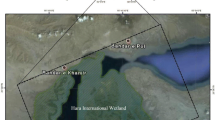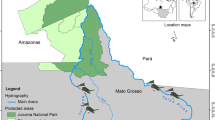Abstract
Mercury concentrations were examined in the liver, kidneys, and tail and breast feathers of common and green sandpipers from Zayanderud Dam in west-central Iran. The aim was to provide indirect information about habitat contamination. Tail feathers of both species had higher mercury levels compared to other tissues. Moreover, tissues of common sandpipers had significantly higher mercury concentrations compared to tissues of green sandpipers. Male specimens of both species had higher values of mercury compared to females. The pattern of larger body size-higher mercury body burden was not completely true in the current study. Smaller and shorter common sandpipers had higher mercury concentrations compared to taller and heavier green sandpipers. At the intraspecific level, body weight was positively correlated with mercury concentrations in tissues of common sandpipers. Based on the data presented here, it appears that these sandpipers, especially common sandpipers, are at potential risk from the toxic effects of mercury.



Similar content being viewed by others
References
Adout A, Hawlena D, Maman R, Paz-Tal O, Karpas Z (2007) Determination of trace elements in pigeon and raven feathers by ICPMS. Int J Mass Spectrom 267:109–116
Becker PH (2003) Biomonitoring with birds. In: Markert BA, Breure AM, Zechmeister HG (eds) Trace metals and other contaminants in the environment, vol 6. Elsevier, Amsterdam, pp 677–736
Burger J (1993) Metals in avian feathers: bioindicators of environmental pollution. Rev Environ Contam Toxicol 5:203–311
Burger J (2002) Food chain differences affect heavy metals in bird eggs in Barnegat Bay, New Jersey. Environ Res 90:33–39
Burgess NM, Evers DC, Kaplan JD (2005) Mercury and other contaminants in common loons breeding in Atlantic Canada. Ecotoxicology 14:241–252
Dauwe T, Bervoets L, Pinxten R, Blust R, Eens A (2003) Variation of heavy metals within and among feathers of birds of prey: effects of molt and external contamination. Environ Pollut 124:429–436
del Hoyo J, Elliott A, Sargatal J (1996) Handbook of the birds of the world, vol 3. In. Hoatzin to Auks, Lynx Edicions
Durell SE (2000) Individual feeding specialization in shorebirds: population consequences and conservation implication. Biol Rev 75:503–518
Eagles-Smith CA, Ackerman JT, Adelsbach TL, Takekawa JY, Miles AK, Keister RA (2008) Mercury correlations among six tissues for four waterbird species breeding in San Francisco Bay, California, USA. Environ Toxicol Chem 27:2136–2153
Eisler R (1987) Mercury hazards to fish, wildlife, and invertebrates: a synoptic review vol 85. US Fish Wildlife Service Biological Report, Vol 85
Ek KH, Morrison GM, Lindberg P, Rauch S (2004) Comparative tissue distribution of metals in birds in Sweden using ICP-MS and laser ablation ICP-MS. Arch Environ Contam Toxicol 47:259–269
Holm S (1979) A simple sequentially rejective multiple test procedure. Scand J Stat 6:65–70
Houserova P, Hedbavny J, Matejicek D, Kracmar S, Sitko J (2005) Determination of total mercury in muscle, intestines, liver and kidney tissues of cormorant (Phalacrocorax carbo), great crested grebe (Podiceps cristatus) and Eurasian buzzard (Buteo buteo). Vet Med (Prague, Czech Repub) 50:61–68
Kim J, Park SK, Koo TH (2007) Trace elements and pollutants concentrations in shorebirds from Yeongjong Island, Korea in the East Asian-Australian migration flyways. Ecotoxicology 16:403–410
Kunisue T, Watanabe M et al (2003) Accumulation features of persistent organochlorines in resident and migratory birds from Asia. Environ Pollut 125:157–172
Kuwae T, Beninger PG, Decottignies P, Mathot KJ, Lund DR, Elner RW (2008) Biofilm grazing in a higher vertebrate: the western sandpiper Calidris mauri. Ecology 89:599–606
Kuwae T, Miyoshi E et al (2012) Variable and complex food web structures revealed by exploring missing trophic links between birds and biofilm. Ecol Lett 15:347–356
Lane O, Edmonds ST, Atwood J, Regan K, Buck D, Evers D (2012) Assessment of mercury in birds at Onondaga Lake: 2008–2009 breeding season. Final report, Biodiversity Research Institute, U.S. Fish and Wildlife Service, Cortland
Lewis SA, Furness RW (1991) Mercury accumulation and excretion in laboratory reared black-headed gull Larus ridibundus Chicks. Arch Environ ContamToxicol 21:316–320
Lewis SA, Becker PH, Furness RW (1993) Mercury levels in eggs, tissues, and feathers of herring gulls Larus argentatus from the German Wadden Sea coast. Environ Pollut 80:293–299
Maclean GL (ed) (2001) Roberts birds of southern Africa, 6th edn. John Voelcker Bird Book Fund, Cape Town
McCormick J, Clair CT, Bendell LI (2014) Concentration and partitioning of metals in intertidal biofilms: implications for metal bioavailability to shorebirds. Ecotoxicology 23:229–235. doi:10.1007/s10646-013-1166-6
Monteiro LR, Costa V, Furness RW, Santos RS (1996) Mercury concentrations in prey fish indicate enhanced bioaccumulation in mesopelagic environments. Mar Ecol -Prog Ser 141:21–25
Nebel S (2005) Latitudinal clines in bill length and sex ratio in a migratory shorebird: a case of resource partitioning? Acta Oecol 28:33–38
Nebel S, Thompson GI (2005) Foraging behaviour of western sandpipers changes with sediment temperature: implications for their hemispheric distribution. Ecol Res 20:503
Nebel S, Jackson DL, Elner RW (2005) Functional association of bill morphology and foraging behaviour in calidrid sandpipers. Anim Biol 55:235–243
Nicholson JK, Osborn D (1983) Kidney lesions in pelagic seabirds with high tissue-levels of cadmium and mercury. J Zool 200:99–118
Robinson SA, Lajeunesse MJ, Forbes MR (2012) Sex differences in mercury contamination of birds: testing multiple hypotheses with meta-analysis. Environ Sci Technol 46:7094–7101. doi:10.1021/es204032m
Snow DW, Perrins CM (1998) The birds of the western Palearctic vol. 1: Non-Passerines. Oxford University Press, Oxford, p 722
Stewart FM, Thompson DR, Furness RW, Harrison N (1994) Seasonal variation in heavy metal levels in tissues of common guillemots Uria aalge from northwest Scotland. Arch Environ ContamToxicol 27:168–175
Thompson DR (1996) Mercury in birds and terrestrial mammals. In: Beyer WN, Heinz GH, Redmon-Norwood AW (eds) Environmental contaminants in wildlife interpreting tissue concentrations. CRC Press LCC, Boca Raton, pp 341–356
Thompson DR, Hamer KC, Furness RW (1991) Mercury accumulation in great skuas Catharacta skua of known age and sex, and its effects upon breeding and survival. J Appl Ecol 28:672–684
Topolski B, Thompson M (2010) Digestion of tissue samples for total mercury analysis. HG-015-2.15, Department of Environmental Protection, Florida: http://www.dep.state.fl.us/labs
van Gils J, Wiersma P (1996) Family Scolopacidae (Sandpipers, Snipes and Phalaropes). In: del Hoyo J, Elliott A, Sargatal J (eds) The birds of the world, vol 3., Hoatzin to AuksLynx Edicions, Barcelona, pp 444–533
Author information
Authors and Affiliations
Corresponding author
Rights and permissions
About this article
Cite this article
Malekian, M., Hosseinpour-Mohamadabadi, Z. Mercury Levels in Common (Actitis hypoleucos) and Green (Tringa ochropus) Sandpipers from West-Central Iran. Bull Environ Contam Toxicol 94, 564–569 (2015). https://doi.org/10.1007/s00128-015-1466-z
Received:
Accepted:
Published:
Issue Date:
DOI: https://doi.org/10.1007/s00128-015-1466-z




